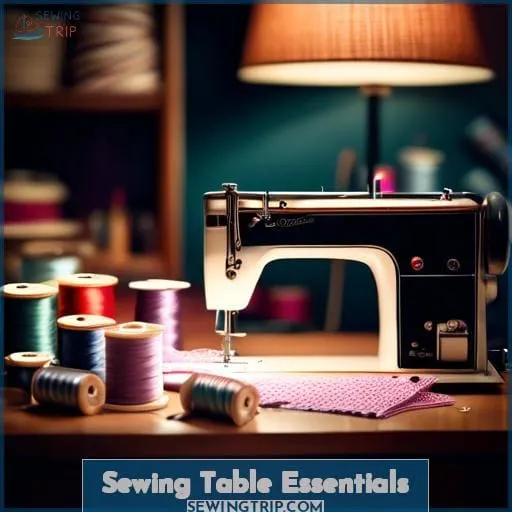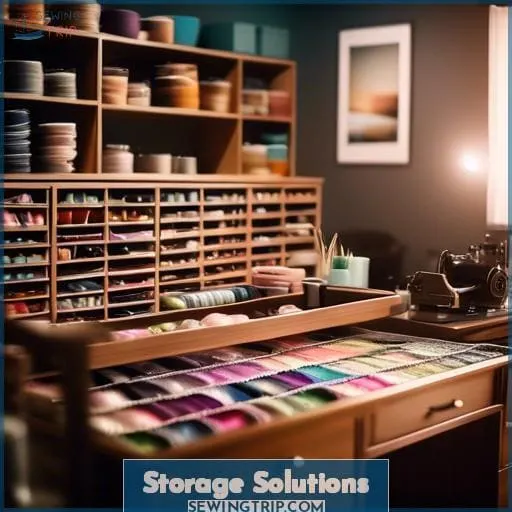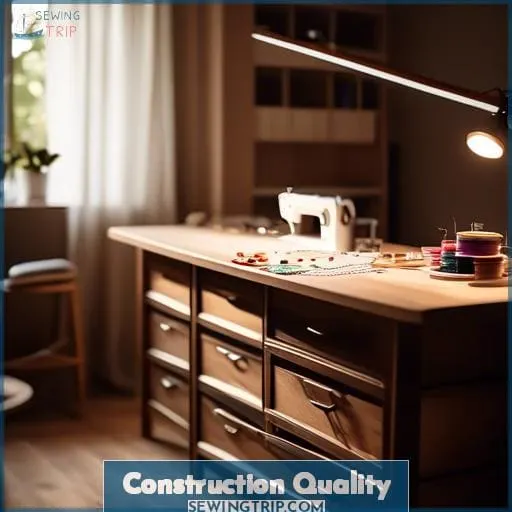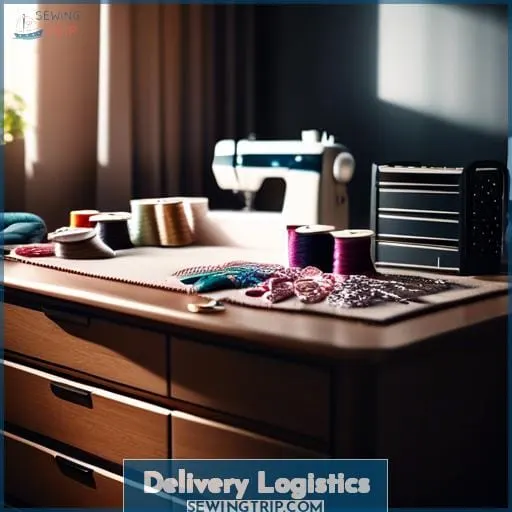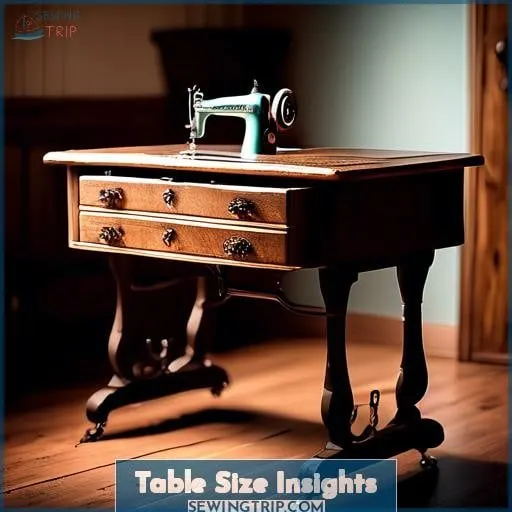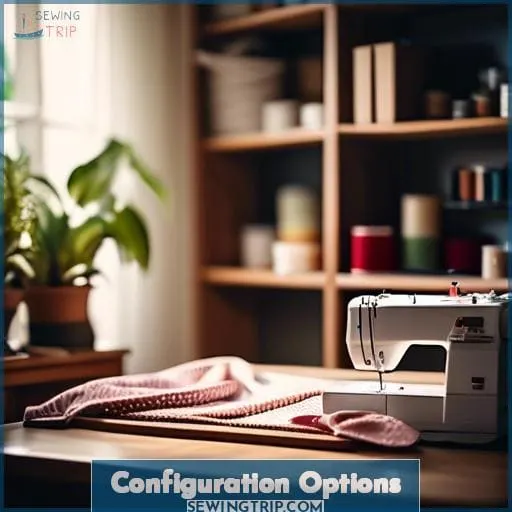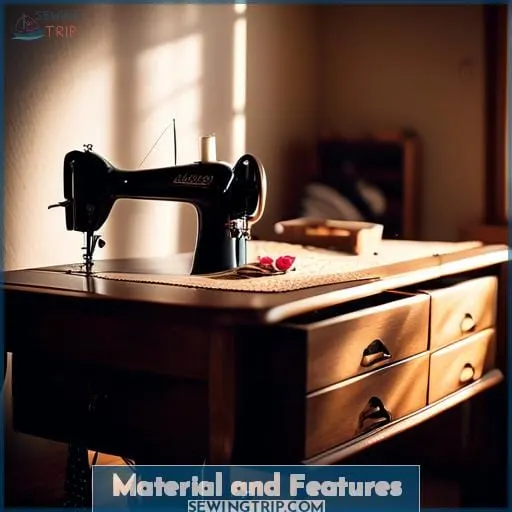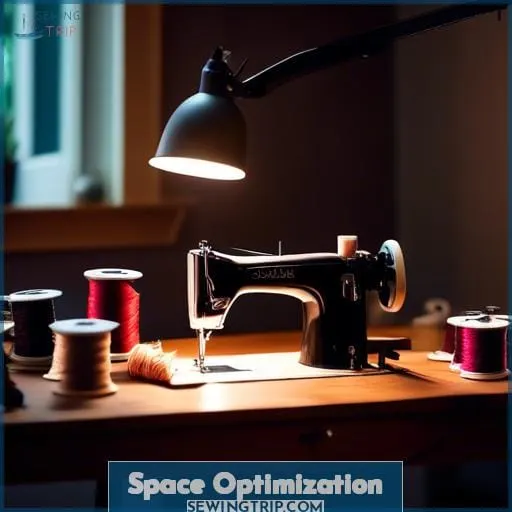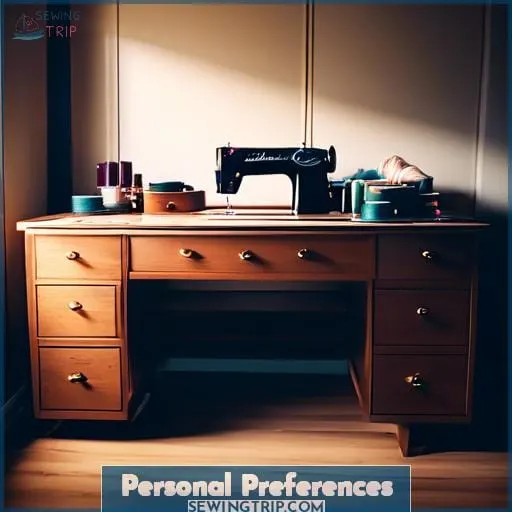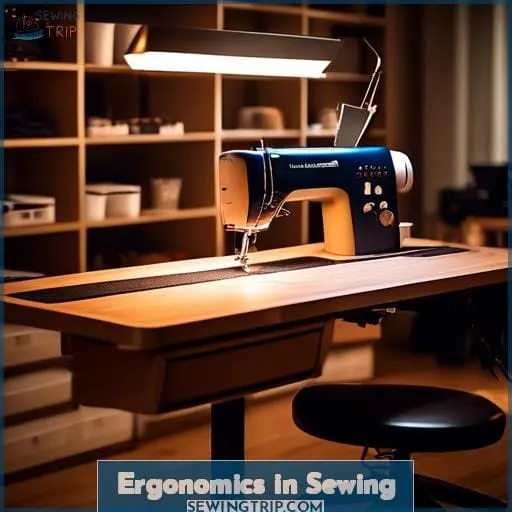This site is supported by our readers. We may earn a commission, at no cost to you, if you purchase through links.
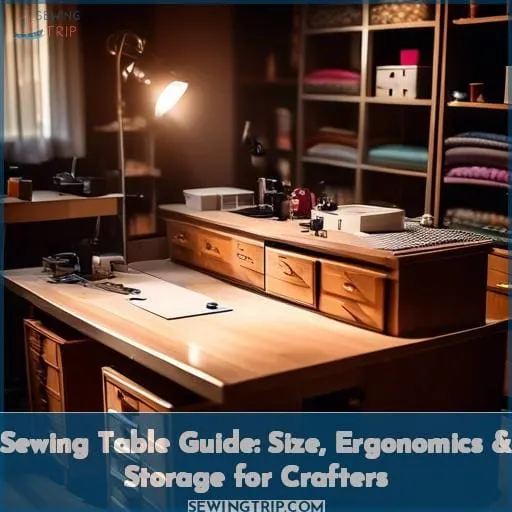 Contrary to popular belief, the quest for the perfect sewing table isn’t just about finding a spot to stash your fabric stash. It’s about crafting a sanctuary where creativity knows no bounds, and your projects come to life effortlessly.
Contrary to popular belief, the quest for the perfect sewing table isn’t just about finding a spot to stash your fabric stash. It’s about crafting a sanctuary where creativity knows no bounds, and your projects come to life effortlessly.
As a crafter, you understand the power of a well-organized, ergonomically designed workspace. It’s not merely a table; it’s your command center, where every tool is at your fingertips, and every stitch is a step towards your masterpiece.
Whether you’re piecing together your next quilt or tailoring a bespoke garment, the right sewing table combines size, storage, and style to keep your creative juices flowing. Let’s dive into the essentials of selecting a sewing table that not only fits your space but elevates your crafting experience to new heights.
Table Of Contents
Key Takeaways
- The ideal height for a sewing table is around 29.5 inches, which can vary slightly to accommodate personal comfort and ergonomic requirements.
- Sewing tables should offer ample space, with larger tables providing around 38 square feet to support big projects and prevent the material from hanging off and disrupting the sewing process.
- Adjustable tables are available for those who need to alternate between sitting and standing, with some models offering height adjustments from 29 to 40 inches.
- Storage solutions are integral to sewing tables, with options ranging from drawers and cabinets for large items to trays, baskets, and magnetic strips for organizing small items.
Sewing Table Essentials
When selecting a sewing table, it’s crucial to consider design aesthetics, machine compatibility, and practical features like mobility and safety. Your choice shouldn’t only complement your sewing room’s decor but also fit your sewing machine perfectly to ensure a seamless sewing experience.
Look for tables with ample storage to keep your essentials organized, and prioritize options with mobility features like caster wheels for easy movement, alongside rounded corners and edges to minimize the risk of injury.
Design Aesthetics
When considering the design aesthetics of your sewing table, it’s essential to choose a piece that not only complements your home decor but also reflects your personal style, within the confines of your crafting space.
- Seek color inspiration from your favorite fabrics to create a harmonious room ambiance.
- Select sewing furniture that balances form with function, ensuring ergonomic height.
- Prioritize table size preferences to fit your space without sacrificing style.
- Integrate design aesthetics that empower and inspire your creative endeavors.
Compatibility With Machines
Having considered the design aesthetics of your sewing space, you’ll want to ensure that any sewing table you choose is compatible with your sewing machine, offering a snug and secure fit to facilitate smooth sewing operations.
This compatibility is crucial for maintaining a seamless workflow and preventing any unnecessary disruptions during your creative process.
A table that aligns perfectly with your machine not only enhances the ergonomics of your sewing setup but also optimizes your sewing experience by ensuring that your equipment integrates flawlessly into your workspace.
By prioritizing machine compatibility, you’re investing in a setup that supports your craft, allowing you to focus on bringing your projects to life with precision and ease.
Mobility and Safety
You’ll appreciate the mobility and safety features of a sewing table, ensuring you can easily move it around your crafting area while keeping sharp tools securely stored away.
Portable options with sturdy construction address maneuverability concerns, allowing you to tailor your sewing room configuration.
Optimal sewing table height and sewing furniture dimensions enhance task lighting, contributing to a safe, dynamic workspace.
Storage Solutions
When considering storage solutions for your sewing table, it’s essential to think about the size of items you’ll be storing. You should also consider how you’ll organize smaller items and keep your tools within easy reach.
A well-designed sewing table should offer ample space for large items in drawers or cabinets. Additionally, it should provide baskets, trays, or recessed surfaces for smaller necessities. Ensuring that your frequently used tools are accessible will streamline your workflow and keep your creative space both tidy and efficient.
Large Item Storage
Adequate storage for your large sewing items is essential. Many sewing tables come equipped with spacious drawers and cabinets to keep everything organized and within reach.
When planning your sewing room or workshop setup, consider furniture layout and closet organization strategies that incorporate container solutions for both visibility and accessibility.
For those with larger equipment or bulk materials, garage storage options or dedicated sewing cabinets can offer the perfect solution.
Look for sewing tables that balance sewing table size with sewing table prices, ensuring you get the best value for your investment.
Whether you’re arranging a cutting table or a multifunctional sewing station, the right storage solutions can transform your space into an efficient and enjoyable crafting area.
Small Item Organization
Maximize your sewing table’s functionality by incorporating organizers for small items such as trays for bobbins, drawers for thread, and baskets for fabric scraps.
- Utilize stackable clear plastic containers for easy visibility
- Implement magnetic strips for organizing metal bobbins and pins
- Use hanging fabric pouches for storing small sewing tools
- Employ a pegboard with hooks for organizing scissors, rulers, and other tools
- Consider a tiered caddy for easy access to frequently used items
Tool Accessibility
Ensuring easy access to your most frequently used tools can significantly streamline your sewing process. Opt for a sewing table with efficient tool storage, incorporating accessible organization features like recessed trays and side holders.
This organized tool access, paired with the right table size and an ergonomic chair, transforms your sewing area into a hub of creativity and productivity.
Construction Quality
When selecting a sewing table, you’ll want to prioritize materials that ensure durability and a work surface that remains smooth for precise fabric handling.
Look for tables with a solid build, such as those made from metal or high-quality wood, which can withstand the rigors of sewing and crafting. Metal sewing tables are usually quite sturdy and offer the most durability, while wooden tables are also sturdy but a little less so than metal types.
Additionally, consider tables that offer easy assembly, with clear instructions and minimal tools required, to streamline the setup process and get you started on your projects sooner.
Material Durability
You’ll want to prioritize durable materials and a sturdy construction when selecting a sewing table to ensure longevity and reliable performance.
Opt for a sewing table with a robust framework that can withstand the rigors of your creative endeavors.
Material durability isn’t just about withstanding the weight of your sewing machine; it’s about ensuring surface resilience for precise cutting and sewing.
A table with a solid build won’t only support your machine but also provide a smooth work surface that’s essential for your projects.
When considering custom sewing furniture, look for options that offer longevity assurance, so your investment continues to serve your sewing room needs over time.
Work Surface Smoothness
When selecting a sewing table, bear in mind that a smooth work surface is crucial for precise fabric cutting and sewing.
- Smoothness Evaluation: Ensure the table’s surface quality supports seamless fabric movement.
- Polished Finish: A polished finish reduces snags, enhancing your quilting space’s ergonomics.
- Workspace Texture: Opt for a surface that balances smoothness with enough grip to hold fabrics in place.
Assembly Ease
The simplicity of assembly is a crucial aspect of construction quality, allowing you to set up your sewing table with minimal hassle and get back to your projects swiftly. When selecting a sewing table, consider user-friendly features that promote assembly ease.
A well-designed sewing table should integrate ergonomic considerations, ensuring that your sewing room furniture, including the cutting table height, aligns with your body for a comfortable crafting experience.
Here’s a quick reference for key assembly features to look for:
| Feature | Benefit |
|---|---|
| Pre-assembled Components | Reduces setup time |
| Clear Instructions | Simplifies the process |
| Minimal Tools Required | Convenience |
| Quick-Connect Hardware | Streamlines assembly |
Choose a sewing table that respects your time and energy, allowing you to focus on creativity and productivity in your ergonomic sewing room.
Delivery Logistics
When planning for the arrival of your new sewing table, it’s essential to consider the logistics of home delivery.
You’ll need to assess whether your space can accommodate the table’s size and if additional tools are required for assembly.
Ensure you have a suitable area prepared for the setup to protect your floors and walls during the process.
Home Delivery Considerations
When considering the logistics of home delivery for your new sewing table, factor in the potential need to rent a truck or clear out space in your vehicle to accommodate the unit’s size.
- Evaluate rental costs versus delivery fees.
- Choose delivery methods that ensure safety and convenience.
- Plan protective measures for your home’s interior.
- Consider assembly options for your sewing room layout.
Assembly Tools and Location
You’ll need a variety of tools for assembly, including wrenches, screwdrivers, a hammer, and an electric driver for screw bits.
Choose a spacious location that allows for efficient assembly and ergonomic setup.
Organizing your workspace and selecting the right tools are key to a smooth process.
Ensure your sewing table’s location and storage solutions support an organized, powerful crafting experience.
Table Size Insights
When selecting the ideal sewing table, it’s crucial to consider both the space available for your materials and the ergonomic comfort necessary for long sewing sessions. An appropriately sized table not only accommodates your projects but also ensures a comfortable working posture, reducing the risk of strain or injury.
Opting for a table that fits well in your sewing space while providing ample room for spreading out materials can significantly enhance your sewing experience and efficiency.
Space for Materials
Choosing the right size for your sewing table is crucial, as it directly impacts your ability to spread out materials and work comfortably on projects of any scale.
A well-chosen table enhances your personal style while minimizing noise levels. Optimal table space and storage solutions elevate quilting and sewing experiences, making every stitch a pleasure.
Ergonomic Comfort
Considering the space needed for your materials, it’s crucial to ensure the sewing table’s size also provides ergonomic comfort to prevent strain during long crafting sessions.
Opt for a sewing table that aligns with ergonomic chair options and standing desk benefits.
Incorporate posture improvement techniques and stretching exercises into your routine.
Enhance your sewing room with optimal workspace lighting suggestions for overall well-being.
Configuration Options
When considering the configuration of your sewing table, it’s essential to explore all available options to ensure your crafting space meets your needs.
Combining tables can offer a larger surface area, but keep in mind that this might make the room feel more cluttered.
Alternatively, drop-leaf and rolling tables provide flexibility and space-saving solutions, allowing you to customize your sewing environment to your current project and space constraints.
Combining Tables
When considering how to best utilize your sewing space, combining tables can offer a versatile solution that adapts to the size and scope of your projects.
- Space Efficiency: Maximizes the use of available space, allowing for larger projects.
- Flexibility Options: Enables quick reconfiguration based on current needs, enhancing creativity.
- Room Aesthetics: Creates functional layouts that complement the sewing room’s design, elevating the overall environment.
Drop-leaf and Rolling Tables
Explore the versatility of drop-leaf and rolling tables to customize your sewing space for both large projects and compact storage. These options offer fold and leaf benefits, rolling table flexibility, and space-saving solutions.
Enjoy the mobility advantages and customization options they bring to your crafting area.
| Feature | Drop-Leaf Tables | Rolling Tables |
|---|---|---|
| Ergonomics | Adjustable to user height | Easily moved for comfort |
| Storage | Hidden when folded | Built-in compartments |
| Mobility | Stationary with flexibility | High mobility |
| Space-Saving | Compact design | Versatile placement |
| Customization | Tailored to project needs | Adaptable to space |
Material and Features
When considering the material and features of a sewing table, it’s essential to focus on the surface types, adjustable heights, and built-in illumination to enhance your crafting experience.
A smooth and durable surface ensures precise cutting and sewing.
Adjustable heights cater to your ergonomic needs, preventing strain during long sewing sessions.
Additionally, built-in illumination offers better visibility, crucial for detailed work, making these features indispensable for a functional and comfortable sewing space.
Surface Types
The choice of a sewing table’s surface material is crucial as it directly affects the durability and functionality of your workspace.
- Heat-Resistant Surfaces: Ideal for ironing and handling hot tools.
- Laminated Tops: Provide a smooth, durable area for cutting and sewing.
- Glass Inlays: Offer a chic look and a hardy surface for precise work.
- Silicone Mats & Acrylic Covers: Protect the table and enhance its versatility.
Adjustable Heights
Adjustable heights in sewing tables offer you the flexibility to tailor your workspace to your body’s needs, ensuring comfort and reducing the risk of strain or injury during long sewing sessions.
Height adjustability transforms your sewing room, allowing for a standing option that promotes better posture and circulation.
This ergonomic feature not only boosts your health but also enhances customization possibilities, making your creative space truly yours.
Built-in Illumination
Moving on from adjustable heights, you’ll find that built-in illumination can significantly brighten your sewing projects, ensuring precision in every stitch.
Task lighting with adjustable brightness complements natural light, while LED lamps integrate seamlessly into your sewing table’s design.
This ergonomic feature not only enhances visibility but also adds to the table’s functionality, marrying storage solutions with optimal dimensions for a well-lit workspace.
Space Optimization
Maximizing the efficiency and functionality of your sewing space is crucial for a seamless crafting experience.
By utilizing vertical storage solutions, such as shelves and pegboards, you can keep essential tools within reach while conserving valuable floor space.
Under-table solutions, like bins or baskets, offer additional storage for fabrics or seldom-used items, ensuring your workspace remains clutter-free and organized.
This strategic approach to space optimization not only enhances your sewing environment but also boosts your creativity and productivity.
Vertical Storage
Maximizing your sewing area involves utilizing vertical storage solutions, allowing you to keep essential items within easy reach while conserving precious floor space.
Wall-mounted organizers, hanging racks, and over-the-door storage transform unused areas into functional spots.
Shelving units above your sewing table or cutting table elevate supplies, liberating your workspace from clutter.
These storage strategies empower you with efficient organization and a streamlined sewing room.
Under-table Solutions
Building on the concept of vertical storage, under-table solutions offer you a clever way to utilize every inch of your sewing space for stashing away bulky items.
- Slide stackable bins under your sewing cutting table for fabric scraps and patterns.
- Tuck a foldable cart beneath for easy access to sewing essentials.
- Install pull-out drawers to maximize organization techniques within your sewing table dimensions.
Personal Preferences
When considering the setup of your sewing space, it’s crucial to reflect on the types of projects you typically undertake and the dimensions of the room you’re working in.
If your sewing endeavors range from crafting small garments to assembling large quilts, the size and functionality of your sewing table need to accommodate these varied tasks comfortably.
Similarly, the spatial layout of your sewing room shouldn’t only fit your chosen table but also allow for easy movement and access to your tools and materials.
This balance ensures a workspace that’s both efficient and conducive to creativity, tailored to your personal sewing habits and the physical constraints of your environment.
Project Types
While optimizing your sewing space, it’s crucial to consider the types of projects you typically undertake, as they’ll significantly influence your table choice and setup.
Customization options cater to project versatility, ensuring your sewing table dimensions and height meld seamlessly with room integration.
An aptly sized sewing cutting table fosters creative inspiration while honoring ergonomic considerations, enhancing comfort and efficiency in your crafting sanctuary.
Room Space Evaluation
You’ll need to assess the available space in your sewing room to determine the best sewing table size and configuration for your needs.
Consider the room layout and furniture placement to optimize space utilization.
Ensure the traffic flow is unobstructed and establish functional zones.
The right sewing table height and size will enhance your sewing cutting table’s efficiency.
Ergonomics in Sewing
When setting up your sewing space, it’s crucial to prioritize ergonomics to prevent injuries and ensure comfort during long sewing sessions.
The right sewing table height can significantly impact your posture and reduce the risk of back, neck, and wrist strain. To find the ideal height, consider the relationship between your body and the sewing surface; your sewing table should allow you to work with your arms at a comfortable angle and your feet flat on the floor, ensuring a pain-free sewing experience.
Preventing Injuries
Ergonomic sewing setups are crucial for preventing injuries and ensuring comfort during long sewing sessions. Customization options in ergonomic furniture, like sewing tables with height adjustments, cater to your body alignment, significantly reducing the risk of strain.
Incorporating injury prevention techniques through the right storage and size choices not only boosts your creativity but also empowers you with a sense of control and understanding in your crafting space.
Sewing Surface Height
Your sewing surface height is crucial for maintaining good posture and preventing strain on your back, neck, and wrists.
Opt for an adjustable ergonomic table to achieve proper alignment, whether you’re engaging in standing sewing or seated tasks.
Customized heights cater to your body’s needs, while DIY solutions can transform your sewing room size constraints into a functional, free-arm sewing haven.
Frequently Asked Questions (FAQs)
How can I ensure my sewing table is child-friendly and safe for a family environment?
To ensure your sewing table is child-friendly, choose one with rounded corners, secure storage for sharp tools, and a lockable height adjustment to prevent accidental operation.
What are the environmental considerations when choosing a sewing table, such as sustainability and recyclability of materials?
When choosing a sewing table, consider sustainability; 85% of textiles end up in landfills annually.
Opt for materials like FSC-certified wood and recyclable metals to reduce environmental impact and support circularity in design.
How does the climate in my region affect the choice of materials for a sewing table?
In your region’s climate, material choice for a sewing table should resist humidity and temperature changes to prevent warping and maintain durability.
Opt for treated wood or metal to ensure longevity and stability.
Can a sewing table be multi-functional for other crafts or office work without compromising its primary purpose for sewing?
Like a chameleon adapting to its environment, a sewing table can seamlessly transition to support various crafts and office tasks.
What are the insurance and warranty options for sewing tables in case of damage or defects?
Arrow Sewing Cabinets offers a limited warranty covering defects in materials, with specific legal rights that may vary by state.
SewingMachinesPlus.com provides Platinum Protection Plans for 1 or 3 years, covering parts, labor, and shipping.
Premier Stitching offers extended warranty plans up to 5 years, including power surge protection.
Horn of America provides a limited lifetime warranty on certain products, with conditions and exclusions.
Always check the manufacturer’s warranty and consider extended protection for peace of mind.
Conclusion
Stepping back in time, imagine the artisans of yore, their workspaces as unique as their crafts. Today, your sewing table should be no different. It’s not just about how big a sewing table is, but how it fits into your creative world.
With the right blend of size, ergonomics, and storage, you’ll craft a space that’s both a sanctuary and a command center. Let your table be the foundation where your creativity flows, unhindered and vibrant.

